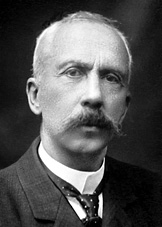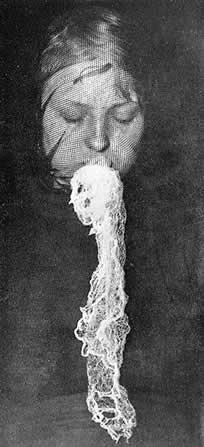|
By Michael Tymn
How can anything so repulsive and so repugnant in appearance be real? And how can there possibly be any spiritual connection with it?
No doubt this is the first reaction of intelligent, rational people who come across old photos in books about paranormal phenomena of a substance referred to as ectoplasm. The photos usually show a seemingly thick foamy or slimy substance – sometimes looking like vomitus, other times like shaving soap, and still at other times more like cheesecloth – flowing from one of the orifices of a so-called ‘medium’ in an entranced state – from the nostrils, mouth, ears, vagina, and even the pores. Some of the photos show what are claimed to be materialized human forms – occasionally just a face or an arm – forming within the ectoplasm.
If we are to believe the debunkers and skeptics, ectoplasm is nothing more than cheesecloth stuffed into one or more of the cavities of the body and then extruded at an opportune time, the sole purpose being to dupe those present. However, it is difficult to believe that some of the most eminent men of science, who observed it, examined it, tested it, and proclaimed it real, could have been fooled over and over again, especially under laboratory conditions.
It stretches the imagination to believe that as much ‘cheesecloth,’ as seen in many of the photographs, could be stored in an orifice of the body, especially the ears and pores, and so dramatically extruded, then to have human forms shaped from it or within it, and then, in some cases, to have those human forms emerging from the ectoplasm and carry on conversations with those present, sometimes about personal matters known only to the sitter.
Equally puzzling is why numerous alleged charlatans would dream up something so seemingly ridiculous and revolting. Couldn’t they come up with a trick a bit more realistic and believable? If it all began with one trickster, why were so many other charlatans impressed by something so bizarre?
‘It is a whitish substance that creeps as if alive, with damp, cold, protoplasmic extensions that are transformed under the eyes of the experimenters into a hand, fingers, a head, or even into an entire figure,’ explained Dr Charles Richet (seen below), the scientist who named it.

Winner of the 1913 Nobel Prize in Medicine, Richet (1850-1935) was a physiologist, chemist, bacteriologist, pathologist, psychologist, aviation pioneer, poet, novelist, editor, author, and psychical researcher. After receiving his MD in 1869 and his PhD in 1878, he served as professor of physiology at the medical school of the University of Paris for 38 years.
It was Richet who gave the name ectoplasm to what had previously been referred to as od, psychic force, and teleplasm. When Sir William Crookes, the esteemed British chemist, first reported on it in connection with the mediumship of Florence Cook, Richet was among the many scientists who scoffed and thought that perhaps Crookes, a pioneer in X-ray technology, had ‘lost it.’
‘I avow with shame that I was among the willfully blind,’ Richet wrote in dedicating his 1923 book, Thirty Years of Psychical Research, to Crookes, commending him for his courage and insight.
‘This ectoplasmic formation at the expense of the physiological organism of the medium is now beyond all dispute,’ Richet stated. ‘It is prodigiously strange, prodigiously unusual, and it would seem so unlikely as to be incredible; but we must give in to the facts…Yes, it is absurd; but no matter – it is true.’
Richet saw it as some sort of exterior (‘ecto’ meaning exterior) protoplasm. In his book, Richet referred to the ectoplasm produced by the medium Marthe Béraud as ‘gelatinous projections,’ explaining that ‘a kind of liquid or pasty jelly emerges from the mouth or the breast of Marthe which organizes itself by degrees, acquiring the shape of a face or limb.

‘Under very good conditions of visibility, I have seen this paste spread on my knee, and slowly take form so as to show the rudiment of the radius, the cubitus, or metacarpal bone whose increasing pressure I could feel on my knee,’ Richet wrote.
Richet further observed that the materializations are usually gradual, beginning with a rudimentary shape and then complete forms and human faces only appearing later on. ‘At first these formations are often very imperfect. Sometimes they show no relief, looking more like flat images than bodies, so that in spite of oneself one is inclined to imagine some fraud, since what appears seems to be the materialization of a semblance, and not of a being. But in some cases the materialization is perfect. At the Villa Carmen I saw a fully organized form rise from the floor. At first it was only a white, opaque spot like a handkerchief lying on the ground before the curtain, then this handkerchief quickly assumed the form of a human head level with the floor, and a few moments later it rose up in a straight line and became a small man enveloped in a kind of white burnous, who took two or three halting steps in front of the curtain and then sank to the floor and disappeared as if through a trap door. But there was no trap door.’
While skeptics find much humor in some of the flat, paper-like materializations, Richet had no difficulty with them. ‘The fact of the appearance of flat images rather than of forms in relief is no evidence of trickery,’ he wrote. ‘It is imagined, quite mistakenly, that a materialization must be analogous to a human body and must be three-dimensional. This is not so. There is nothing to prove that the process of materialization is other than a development of a completed form after a first stage of coarse and rudimentary lineaments formed under the cloudy substance.’
Richet referenced one sitting in which a communicating spirit said that he could not materialize because he could not remember what he looked like when alive. At a later sitting, this same spirit materialized in body but without a face. In effect, the success of the materialization appears to depend upon the ability of the particular spirit to visualize his old self and somehow project that thought-image into the ectoplasm. Apparently, the ability to do this varies as much with spirits as does artistic ability among humans.
Richet also observed somewhat similar phenomenon with Eusapia Palladino, the controversial Italian medium, although never a full body materialization. She most often produced ectoplasmic arms. He referred to it as a kind of supplementary arm that came from Palladino’s body. ‘Once I saw a long, stiff rod proceed from her side,’ he explained, ‘which after great extension had a hand at its extremity – a living hand warm and jointed, absolutely like a human hand.’
Replying to skeptics, Richet said that we have no warrant to deny a phenomenon because we do not know its laws. ‘If that were the case we should have to close all scientific books.’
While the ‘veil-like’ or ‘cheesecloth’ form is often seen in photographs taken in infrared or phosphorescent light, ectoplasm apparently comes in many forms, including gaseous, liquid, or fibrous. It can assume different colors from soft white to gray and black. It can move slowly but disappear in a flash. It can be stiff or pliable. It can be invisible, seen only by clairvoyants, or seen by all present.
The inconsistent nature of ectoplasm is just one of many aspects of it that defies scientific scrutiny and gives fuel to the attacks by debunkers. Adding to this is the fact that darkness is usually required. This is because the ectoplasm is said to be sensitive to light rays, and exposure to light can result in serious injury to the medium, who must reabsorb the ectoplasm at the conclusion of the séance before the lights are turned on. Further complicating the observation is the fact that a materialization ‘cabinet’ is usually required. This cabinet is often nothing more than a corner of the room curtained off for the medium to sit within. It further protects the medium from light rays but is said to also be necessary to concentrate the ectoplasm and permit the spirits a certain privacy in their attempts to take shape.
Of course, the debunkers see the cabinet as nothing more than a ‘dressing room’ which permits the fraudulent medium to quickly change costumes and emerge from the cabinet as a spirit entity. To advance such a debunking theory is to assume that men like Richet, Crookes, Professor Gustave Geley, Baron (Dr) von Schrenck Notzing, and a dozen or more other distinguished scientists were duped over and over again under controlled conditions. Only the most arrogant and closed-minded person would dare challenge the observations of these respected scientists without doing any kind of investigation of his or her own, but there were many who continued to scoff and sneer.
Next: Part 2
|